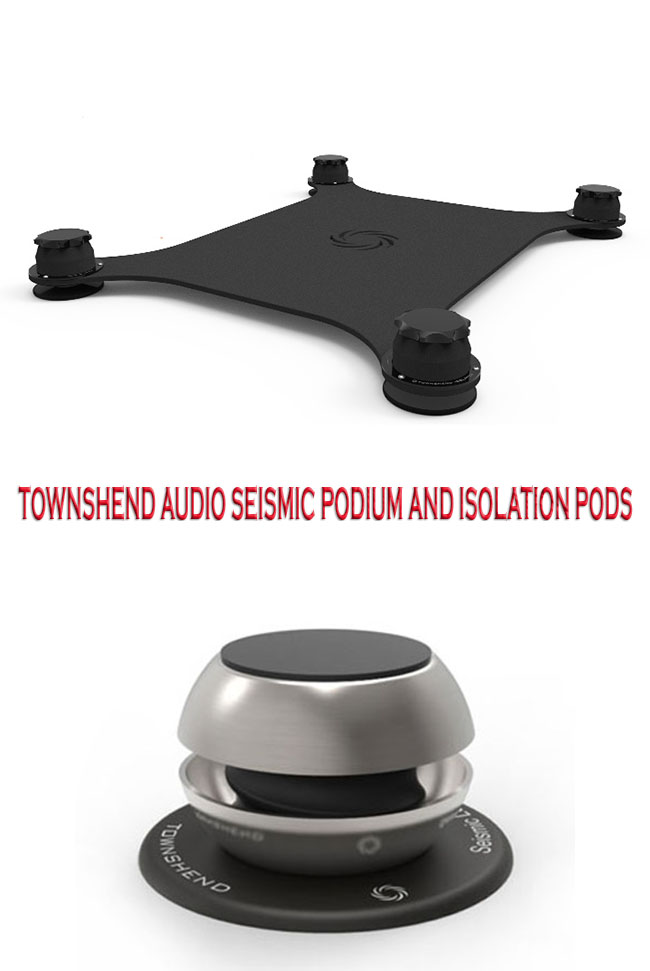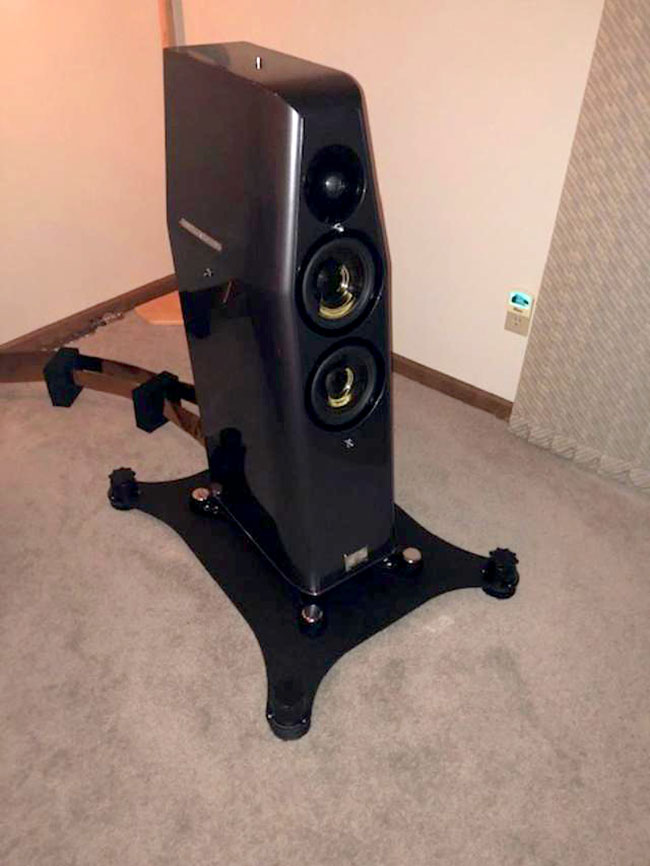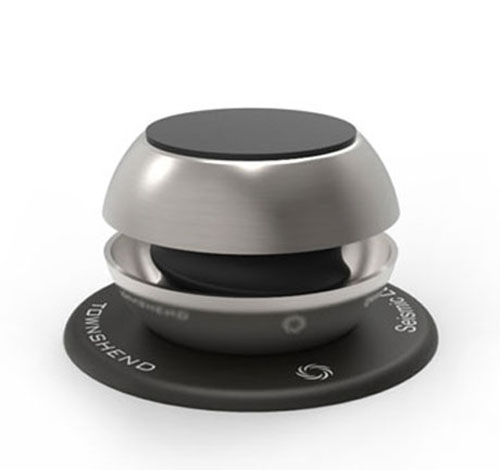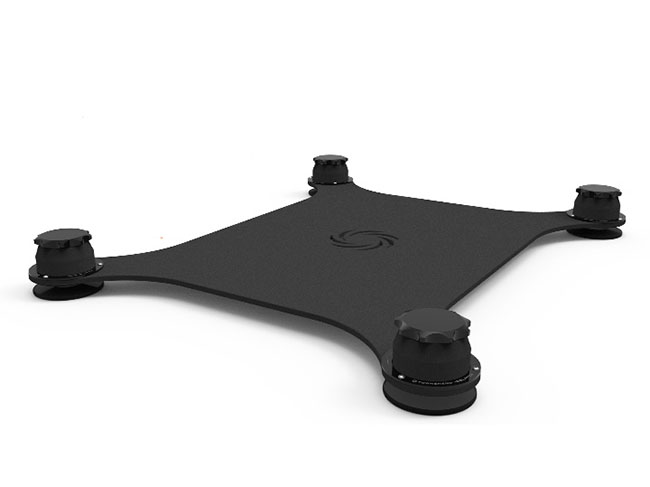Townshend Audio Seismic Podiums and Isolation Pods by Bill Wells

 Despite my general hesitancy around installing tweaks in my reference audio system, I have also learned from experience, including both the good and sometimes not-so-good, for various types of tweaks. For example, earlier this year, I had the opportunity to audition, evaluate and conduct a review of room treatment devices (i.e., tweaks, if you will) and concluded from my observations that there was indeed merit to how they improved the sound of my system and specifically in my listening room environment. It was also interesting to hear comments made by various friends, particularly my wife, who are all quite familiar with how my system reproduces music and, for the most part, have no real interest in the equipment or cables. For them, the focus is strictly on the end result. In terms of first becoming aware of the Townshend Audio Seismic Podiums, my initial reaction was again a general hesitancy and a feeling like perhaps this was another of the myriad of tweaks available.
Despite my general hesitancy around installing tweaks in my reference audio system, I have also learned from experience, including both the good and sometimes not-so-good, for various types of tweaks. For example, earlier this year, I had the opportunity to audition, evaluate and conduct a review of room treatment devices (i.e., tweaks, if you will) and concluded from my observations that there was indeed merit to how they improved the sound of my system and specifically in my listening room environment. It was also interesting to hear comments made by various friends, particularly my wife, who are all quite familiar with how my system reproduces music and, for the most part, have no real interest in the equipment or cables. For them, the focus is strictly on the end result. In terms of first becoming aware of the Townshend Audio Seismic Podiums, my initial reaction was again a general hesitancy and a feeling like perhaps this was another of the myriad of tweaks available.
By chance, during a Saturday afternoon conversation with one of my fellow StereoTimes colleagues (Moreno Mitch), he abruptly changed what I was pursuing about audio gear. He emphatically stated that whatever I was pursuing that I should put it on hold. He then went on to start singing his praises for the positive results he had achieved by installing a pair of Seismic Podiums under his reference speakers. After finishing our conversation and out of curiosity, I started digging around for information regarding this company and its various products. I found very impressive feedback from various sources, and for the most part – I came across nothing that would deter me from moving forward.
Next up was direct contact with key personnel at the Townshend Audio factory in the U.K. We had an enjoyable initial interaction and were receptive to my consideration for checking out their various products, specifically those targeted around isolation – for both speakers and electronics, along with acknowledging the praise and enthusiastic feedback from my colleague as well. Several follow-up emails finally nailed my requirements, including the appropriate size of Seismic Podiums. Additionally, shipping information and timing quickly moved along, and several weeks later, I was in possession of the Seismic Podiums for my system. For the most part – with my speakers securely coupled to the floor of my listening room, including the manufacturer’s recommended mounting brackets and special spikes, as well as being on top of carpet with a thick pad underneath over a concrete slab, I felt that there wasn’t much more that needed to be done. In this regard, the Townshend Seismic Podiums take a completely different approach, and with a deeper view of how they isolate the speakers from the floor vs. direct coupling, this seemed to have merit.
My initial effort would be to replace my current manufacturer-recommended speaker setup by removing the sophisticated footer bracket and accompanying spikes. When the Seismic Podiums arrived shortly after my negotiations with the factory, the good news was that they were already put together and without any complicated assembly required on my part. Removing them from the individual shipping boxes revealed two heavy platform-type devices made of steel and textured black semi-gloss finish. A quick examination and the overall construction and finish appeared solid and without any flaws.
 Incorporated into the design were what Townshend refers to as their Captive Load Cells. These devices are located at each corner of the podium and with each corner extending outward. This definitely enhances the overall stability of the speaker that’s placed on the podium base plate. The load cells are adjustable independently and allow for increasing the height and balance – as well as from side to side and front to back. This is a very nice feature since speakers vary in their overall design, with weight displacement as a consideration. With the flexibility of the load cells – the user can easily adjust for this. Detailed instructions are included and are fairly straightforward. As I mentioned earlier, we were set once we determined the appropriate size of podium needed to accommodate my speakers. Fortunately, Townshend provides five different sizes based on different sizes and weights of speakers. Beyond these five standard sizes, they also offer custom-designed podiums with additional load cells, allowing for very large and very heavy speakers.
Incorporated into the design were what Townshend refers to as their Captive Load Cells. These devices are located at each corner of the podium and with each corner extending outward. This definitely enhances the overall stability of the speaker that’s placed on the podium base plate. The load cells are adjustable independently and allow for increasing the height and balance – as well as from side to side and front to back. This is a very nice feature since speakers vary in their overall design, with weight displacement as a consideration. With the flexibility of the load cells – the user can easily adjust for this. Detailed instructions are included and are fairly straightforward. As I mentioned earlier, we were set once we determined the appropriate size of podium needed to accommodate my speakers. Fortunately, Townshend provides five different sizes based on different sizes and weights of speakers. Beyond these five standard sizes, they also offer custom-designed podiums with additional load cells, allowing for very large and very heavy speakers.
At this point, rather than going into a detailed description of the step-by-step setup procedure, I am inclined to get right to the point. In fact, I will come back to this later in my review. What I am anxious to share with you is the good news of what impact these devices had in my system and how placing them directly under my speakers minus the factory rig. There was an immediate and very noticeable sonic effect. Clearly, the level of improvement was so immediately obvious to both me and my grandson, who was there to help lift the speakers onto the podiums, that we looked at each other with big smiles and several high fives. Instantaneously, the midrange became more open, clearer, more relaxed, smoother, and more natural sounding. Bass had better control and, at the same time, improved articulation along with greater dynamic impact. Highs were definitely cleaner and clearer.
And this was just the beginning, and without precisely dialing in the podiums by adjusting the load cells. From this point, our adjustment tasks were relatively simple, and we were good to go once we achieved the proper front-to-back and side-to-side balance. Using a balance bubble helped and took out guessing from the equation. With placement of your speakers onto the podium, I suggest you use masking tape to ensure you get your speakers back near the same place they were before. Additionally, your speakers may sit slightly higher than before with the podiums, so be aware of this. For my situation – this actually helped by raising the tweeter level slightly.
Once I was able to take some time and get everything dialed in, which was a relatively easy task and not much more than what I’ve done in the past to get the placement of my speakers just right. Moving the speakers forward or backward may require a slight adjustment of the load cell, which is not difficult at all. Listening at this point became much more intentional and for the greater discernment of what was really happening with the Seismic Podiums in place. Essentially by placing my speakers on the Seismic Podiums, my speakers were now on a floating platform and decoupled from the floor. The result of this was to basically remove potential vibrations that could travel back up into the speakers. Breaking this connection just makes sense; now I could hear and experience this for myself and in my system.


At this point, my wife entered the room without seeming curious about what I had just done. It was her reaction that was quite telling. Basically, her comments focused on how much she was enjoying the sound even better than before and then went on to describe, in her own non-audiophile-oriented words, how there seemed to be noticeably greater clarity and realism to the music. And rather than a quick listen – she remained transfixed, listening for a significant period and as well as requesting to hear some of her favorite artists. With Tidal streaming at my ready – her wish was my command that actually caused an impromptu listening session that continued well into the evening.
Subsequent listening sessions provided me with time to focus on specific sonic attributes of what I hoped to achieve. For the most part, and with such a broad sweep of improvement with the Seismic podiums, my system sounded better than before in all respects. In fact, there wasn’t any area where I felt the sound either remained the same or diminished in any way. What led me to believe and better understand was how even subtle vibrations can cause varying degrees of sonic degradation. One of the most obvious observations was the level of quiet and drop in the noise floor. Since nothing had changed with my equipment or cables, it simply had to be the removal of noise-induced distortion that was effectively removed with the Seismic Podiums in place. Quiet passages became even more expressive in terms of subtle musical details emerging. In fact – all musical sounds emerged from a blacker background that helped even subtle sounds to be illuminated in very natural ways.
 For example, listening to the pristine and highly engaging Shirley Horn’s award-winning recording “Here’s To Life” – the blacker background on the selection titled Estate’ was simply gorgeous. Softer musical sounds emerged from the soundstage in a very compelling manner. Interestingly, the music seemed to slow down just a smidgen, likely due to the very relaxed, open manner in which sounds were emerging. Then moving to something very dynamic and percussive in all ways, listening to Ahmad Jamal’s rendition of the title cut “Blue Moon” from his recording with the same title – it was truly amazing to hear the level of improved control and clarity. Any previous vestige of slight or subtle smearing was significantly reduced and replaced by a clear, wide-open, highly detailed percussive sound with leading/trailing transient attacks fully in control. Whether it was Ahmad’s heavy hitting on the piano keys or the drummer who literally wails away on this cut – the intricate interplay between each of the performers becomes quite obvious.
For example, listening to the pristine and highly engaging Shirley Horn’s award-winning recording “Here’s To Life” – the blacker background on the selection titled Estate’ was simply gorgeous. Softer musical sounds emerged from the soundstage in a very compelling manner. Interestingly, the music seemed to slow down just a smidgen, likely due to the very relaxed, open manner in which sounds were emerging. Then moving to something very dynamic and percussive in all ways, listening to Ahmad Jamal’s rendition of the title cut “Blue Moon” from his recording with the same title – it was truly amazing to hear the level of improved control and clarity. Any previous vestige of slight or subtle smearing was significantly reduced and replaced by a clear, wide-open, highly detailed percussive sound with leading/trailing transient attacks fully in control. Whether it was Ahmad’s heavy hitting on the piano keys or the drummer who literally wails away on this cut – the intricate interplay between each of the performers becomes quite obvious.
The same positive results were achieved on a wide range of recordings – whether solo artists, small ensembles, larger orchestral pieces, instrumental or vocal, regardless of the genre. And for the most part – many of my favorite recordings allowed me to more easily hear deeper into the music and with a better appreciation of the artistic intent of the arrangers, composer, and particularly the performing artists. Again, thanks to what the wonderful Seismic Podiums are doing to isolate the speakers via a floating platform arrangement designed to eliminate vibrations and noise from getting into the speakers.

 After achieving such significant improvements, it was time to introduce the Townsend Isolation Pods into my system. These would be used in conjunction with my current equipment rack, which had been designed with solid vibration control and served me quite well. The Townshend Isolation Pods were not designed to fully replace my rack. They offered a noticeably different approach similar in concept to how the Seismic Podiums provided floating isolation to minimize/eliminate structural vibrations from entering into the equipment. As such, I used these devices under each of my electronic components and according to the instructions. Each of these devices has a designated weight range that is important to ensure proper compression of the isolation device. A positive aspect of this design type is the ability for somewhat instantaneous comparisons; no break-in is required. Install them per instruction, adjust accordingly and listen. Remove and replace with whatever isolation setup used previously and listen again for a quick observation of whatever differences they might be.
After achieving such significant improvements, it was time to introduce the Townsend Isolation Pods into my system. These would be used in conjunction with my current equipment rack, which had been designed with solid vibration control and served me quite well. The Townshend Isolation Pods were not designed to fully replace my rack. They offered a noticeably different approach similar in concept to how the Seismic Podiums provided floating isolation to minimize/eliminate structural vibrations from entering into the equipment. As such, I used these devices under each of my electronic components and according to the instructions. Each of these devices has a designated weight range that is important to ensure proper compression of the isolation device. A positive aspect of this design type is the ability for somewhat instantaneous comparisons; no break-in is required. Install them per instruction, adjust accordingly and listen. Remove and replace with whatever isolation setup used previously and listen again for a quick observation of whatever differences they might be.
As I mentioned – my equipment rack is very sturdy and, from the best I can tell, does an excellent job of not transmitting vibrations into my electronics. Nonetheless, I was willing to see how these small devices could complement the already positive results I had achieved using the Seismic Podiums under my speakers. In checking the Townshend Audio website, the primary sonic benefits of the Isolation Pods were listed as the following:
· Elimination of structure-borne feedback between speaker and vibration-sensitive equipment;
· Bass definition is improved
· Enhances clarity over the entire frequency range
· Wider and deeper sound stage
As the saying goes, the proof of the pudding is in the eating. So by carefully placing these devices underneath and in each corner of my electronics, I was anxiously awaiting to hear to what degree further improvements resulted.
From a visual perspective, each component was raised slightly and suspended from direct contact with my equipment rack. This task was straightforward and took a minimal amount of time to place each device such that the weight of each component was equally distributed to the Isolation Pods. Once this was achieved – it was time to do some listening. At first, listen and with familiar recordings – the differences were subtle yet noticeable and fortunately in positive ways. Further intense listening helped me appreciate these devices’ sonic benefits, which provided improved clarity and inner resolution across the entire musical spectrum. Any concern that dynamics might be negatively impacted quickly went away, and as I continued to listen with the Isolation Pods in place – I could further appreciate how even the elimination of subtle vibrations from my equipment was now enhanced to another level.
 And beyond just the structural vibrations, the Isolation Pods also address various types of airborne disturbances.
And beyond just the structural vibrations, the Isolation Pods also address various types of airborne disturbances.
This is not quite to the extreme of what might be found in a recording studio, and or sure, this approach is a far more convenient and affordable approach.
In terms of further describing the positive impact of the Isolation Pods – what I did not attempt to do was to remove the Seismic Isolation Podiums for a possible assessment of their benefits on their own.
And even without performing this approach, I strongly feel that Isolation Pods can easily stand on their own and effectively improve the vibration control of electronic components universally.
Now I have the complete Townshend isolation process in place. Essentially, my system’s clarity and inner resolution have taken a step forward, with subtle details in the recordings becoming more obvious and distinct and no longer buried in background noise that is often induced by airborne or structural vibrations. For a quick reference to additional details around both the Seismic Podiums and Isolation Pods, I suggest you check the Townshend website at: http://www.townshendaudio.com/hi-fi-home-cinema-equipment-vibration-isolation/seismic-isolation-pods/.
Final Thoughts and Conclusion
With these two very innovative products currently in my system, I have been able to very effectively enhance (and improve) the sound without taking extreme measures. In fact, both products make sense in terms of their design and application. Additionally, due to their varying sizes and shapes, the Seismic Podiums, in particular, are very flexible and adjustable to address a large range of speakers. In terms of the Isolation Pods – similarly, they are adjustable for different weights of electronics and just do what they are designed to do. Both products are highly recommended; for me, they are absolute keepers. Check Please!


bill wells
SEISMIC PODIUM COST – COLOR / SIZE:
· Color option: silver, graphite (light black), custom color – $2,800
· Size: 1 through 5 — pricing ranges from $1,495 per pair to $2895 per pair. Custom sizes are also available upon request
· Weight capacity: come in six different weight range capacities, from approximately 11 lbs to 440 lbs per Seismic Podium. Custom designs are available for loads over 440 lbs., including additional Load Cells.
ISOLATION PODS COST
· Pods come in sets of 4 sizes ranging in weight capacity from 1 lb to 400 lbs per set, priced at $125 each; set of 4 = $600
MANUFACTURER INFORMATION
Name: Townsend Audio
Address: 7 Bridge Road 7, East Molesey, KT8 9EU 7,
Tel: +44(0) 208 979 2155
Bill’s ASSOCIATED EQUIPMENT
Amplification & Digital Playback System
· Bel Canto Design – Black System: ASC2 Asynchronous Stream Controller (line stage) and MPS1 Power Stream units (monoblock amplifiers), including internal DACs
· Tidal/Qobuz – hi rez streaming services
Loudspeakers
· Kharma Elegance DB7 Signature
Cabling
· Fiber Optic – interconnection links
· Cardas Clear Beyond XL – power and speaker cables
· Fidelium – speaker cables
· Synergistic Research – Atmosphere Euphoria SX power and speaker cables
Accessories
· Cardas Nautilus AC power strip
· Furtech NCF Nano AC receptacles
· Matrx Systems equipment rack
· Shakti Halographs
· Synergistic Research – PowerCel 12 UEF, FEQ Frequency Equalizer, Black Box, HFT’s and cable lifters
· Ultra Resolution Technologies – isolation Base
Stereo Times Masthead
Publisher/Founder
Clement Perry
Editor
Dave Thomas
Senior Editors
Frank Alles, Mike Girardi, Russell Lichter, Terry London, Moreno Mitchell, Paul Szabady, Bill Wells, Mike Wright, and Stephen Yan,
Current Contributors
David Abramson, Tim Barrall, Dave Allison, Ron Cook, Lewis Dardick, John Hoffman, Dan Secula, Don Shaulis, Greg Simmons, Eric Teh, Greg Voth, Richard Willie, Ed Van Winkle, Rob Dockery, Richard Doran, and Daveed Turek
Site Management Clement Perry
Ad Designer: Martin Perry









Be the first to comment on: Townshend Audio Seismic Podiums and Isolation Pods by Bill Wells